Cyril Roger Brossard
Well-known member
- Joined
- Aug 30, 2012
- Messages
- 408
An article from The National. (not dated)
DUBAI // Overlooking the abras and wind towers of Dubai Creek, Jamila Bu-eisha reflects on the treasure that brought the Gulf its first taste of wealth. "In myths and legends, pearls were associated with beauty, longevity and perfection," she says.
"It was very expensive, very valuable. This explains why people used to dive and have a very risky job to provide the market with pearls." Ms Bu-eisha is the manager of the Pearl Museum, located on the Creek in the glittering towers of the National Bank of Dubai. The museum is home to the personal collection of Sultan al Owais, one of the bank's founders and the son of a pearl merchant. Mr al Owais donated his natural pearl collection, one of the largest in the world, as a reminder of the little jewel that brought trade to the Gulf and hardship to the divers who risked death to find it.
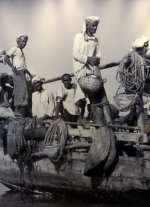
Life in the region revolved around the pearl for centuries, according to archaeological evidence, from the Late Stone Age in the 6th/5th millennia BC. References to Gulf pearls in Asian literature date to the second millennium BC. In the seventh century BC, the Epic of Gilgamesh, a poem from Mesopotamia that is among the first recorded examples of literary fiction, describes how the hero dived to the depths of the sea with weights tied to his feet for the "flower of immortality", a famous early reference to pearling. In the first century AD, Pliny declared that pearls were the most prized goods in Roman society, with those from the Gulf the most esteemed.
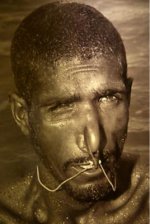
And the attraction has transcended earthly concerns; the Bible likens Heaven to a "pearl of great price", the Holy Quran promises pearls in paradise. According to one tradition, pearls were raindrops caught by an oyster. In fact, a pearl is made when an irritant enters an oyster shell. To protect itself, the oyster coats the irritant with a substance called nacre, commonly known as mother-of-pearl. As the months and years pass, the layers of nacre form the pearl.
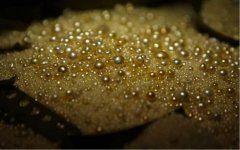
For the men who harvested the pearl, it was more than an object of beauty; it was a way of life. For a people with few resources on land, this jewel of the sea offered opportunity. "Everything was really hard for them," says Ms Bu-eisha. "Although it was a risky job, they hardly ate. You can say they supported their families with food and that's that. That was the whole point of diving." Although the divers were very poor, she says "the pearls were very valuable. The final product was very expensive. The divers didn't get a big price for it. It was a raw material."
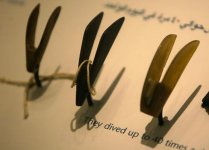
Divers, rope haulers and captains would head to the pearl banks for four months every summer with the most basic necessities. Divers worked from sunrise to sunset, wearing only a nose clip, leather finger protectors, a stone weight and, sometimes, a cotton suit to protect them from jellyfish. In one or two minutes, the diver would descend at least four fathoms (seven metres) and put oysters in a basket before being hauled back to the surface. "He has only one or two minutes to spend under the water," says Ms Bu-eisha. "Imagine yourself under this kind of pressure."
In the Middle Ages, Bahrain and, to a lesser extent, Julfar, near the modern city of Ras al Khaimah, served as the main trading centres because of their manpower and natural resources, despite their distance from the pearl banks. In his 2005 paper, The History and Prehistory of Pearling in the Persian Gulf, published in the Journal of the Economic and Social History of the Orient, the British archaeologist Robert Carter recorded that Julfar, 300km from the pearl banks, was named by the Arab geographer al-Idrisi as a long-established pearling centre in the 12th century, while Gasparo Balbi, the 16th-century Venetian court jeweller, claimed that the pearls of Bahrain and Julfar were the most precious.
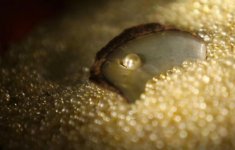
The warm, shallow waters of the Gulf were known to produce the world's finest pearls. "The Arabian oysters are smaller; however, there is a bigger chance of having perfectly round pearls and the lustre is really high," Ms Bu-eisha says. "According to classical standard, black pearls were not really valued in those days ... white, pink and gold-coloured pearls were the most desired. The one-colour pearl is the most valuable because it can fit in a set so easily and it has the feature of being perfect."
Pearls from the region were exported to India, Persia and Turkey and sold on to European and Chinese markets; the Gulf's industry boomed with integration into global markets, particularly after the mid-18th century. As the demand for pearls increased, so did their value. By the mid-18th century, the high value led to trading centres being established in other places, even those with limited natural resources, such as Kuwait, Abu Dhabi, Dubai and Sharjah.
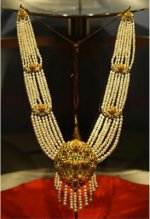
The trade attracted divers from Yemen, the Indian Ocean island of Suqotra and Oman's Batinah Coast, while merchants from India, Iran and other Arab countries came to Dubai to sell rice, spices and textiles. Hindu moneylenders controlled the pearl trade as financiers to the industry and, by the mid-19th century, nearly all Gulf pearls were exported to Mumbai, the world's largest pearl market. Pearls rarely stayed in the Gulf, where few could afford them. Dr Carter notes that in less than 120 years, from 1790 to 1905, the value of pearls grew sixfold. Between 1830 to 1900, Gulf pearls generated revenue of about US$1.75 million a year - then a vast sum - and in the early 20th century this figure rose to $4 million.
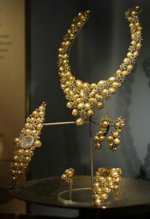
As demand rose, the number of pearling ships increased, from 3,000 in the 1810s to an estimated 4,500 90 years later. In 1907, Bahrain and the Trucial States had fleets of 917 and 1,215 respectively. In Dubai, the number of ships more than tripled to 335 between 1844 and 1907, positioning it as a major trade centre. In 1878, about 35,000 men worked in pearling in the Gulf. These numbers had more than doubled to 74,000 by the early 20th century. At its height, it is estimated that 80,000 worked in the industry. At this point, says Dr Carter, "the entire male population" of Dubai, Abu Dhabi and Qatar toiled in pearling, as did 50 to 70 per cent of the male population of Umm al Qaiwain, Sharjah and Kuwait.
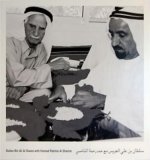
According to the Bank of England, on the Mumbai market in 1917 a single gram of quality Gulf pearls was equivalent in value to approximately 320g of gold or 7.7kg of silver. It all sounded too good to last - and it was; 1917 proved to be the height of the pearling trade in the Gulf. In his Gazetteer for 1908/15, John Lorimer, an official of the Indian Civil Service, wisely observed: "Pearl fishing is the premier industry of the Persian Gulf. It is, besides being the occupation most peculiar to that region, the principal or only source of wealth among the residents of the Arabian side. Were the supply of pearls to fail, the trade of Kuwait would be severely crippled, while that of Bahrain might - it is estimated - be reduced to about one-fifth of its present dimensions and the ports of Trucial Oman [the UAE], which have no other resources, would practically cease to exist."
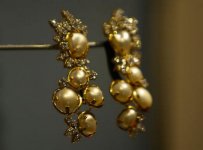
What Lorimer feared came to pass, though the supply of pearls did not fail. "In 1917 the pearl value got to its peak," Ms Bu-eisha says. "Cartier bought a whole building in Manhattan, New York, with just one necklace - two strings of pearls. The value of the necklace was about $1.2 million. This was a massive amount of money. The shocking thing is that the same necklace was again sold in the 1940s for $157,000."
The demise of the natural pearl industry can be laid at the door of one man: in the late 19th century the owner of a small Japanese pearl oyster farm began to perfect the art of the cultured pearl. Instead of waiting for nature to take its course, Kokichi Mikimoto seeded the oysters with irritants to provoke the growth of pearls. It took him more than a decade to perfect the art, but by 1916 Japan started to flood the market with cultured pearls. By the 1930s, hundreds of Japanese farms were producing millions of pearls a year, cheap alternatives to the natural versions that were so hard and so expensive to harvest. It hit the Gulf hard.

"Here in Dubai, people were very poor," says Ms Bu-eisha. "When the cultured pearl was discovered people got even poorer, to the extent that they didn't have anything to eat. It was starvation." The last major pearling fleet set off from Dubai in 1949, by which point pearls had lost more than 90 per cent of their value. With the commercial exploitation of oil, and the employment opportunities it presented, pearling ended completely.
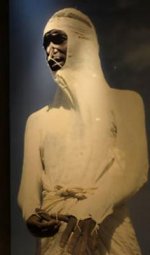
"Some visitors ask, why don't people go diving again? It was a very risky job and so many people had bad memories of diving. Yes it was part of their life, but so many people lost their brothers, their fathers, their cousins. it was a tough life. No one wants to go there again." Yet the history of Gulf pearls has not ended entirely. Off the shores of Ras al Khaimah, tens of thousands of pearls now grow in a farm near the village of al Rams. In 2004, Imura Daiji from Japan and Abdulla Rashid al Suwaidi from Ras al Khaimah established the Emirates and Japan Pearl Cultivation and Trading Company. The pair hope their pearl farm, the first of its kind in the UAE, will create a new chapter in the 7,000-year history of pearling in the Gulf.
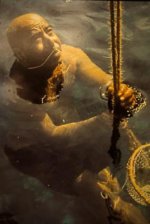
Meanwhile, Japan's pearl farms are threatened by competition from China, whose low-cost freshwater pearls now supply an estimated 95 per cent of the world's pearls
DUBAI // Overlooking the abras and wind towers of Dubai Creek, Jamila Bu-eisha reflects on the treasure that brought the Gulf its first taste of wealth. "In myths and legends, pearls were associated with beauty, longevity and perfection," she says.
"It was very expensive, very valuable. This explains why people used to dive and have a very risky job to provide the market with pearls." Ms Bu-eisha is the manager of the Pearl Museum, located on the Creek in the glittering towers of the National Bank of Dubai. The museum is home to the personal collection of Sultan al Owais, one of the bank's founders and the son of a pearl merchant. Mr al Owais donated his natural pearl collection, one of the largest in the world, as a reminder of the little jewel that brought trade to the Gulf and hardship to the divers who risked death to find it.

Life in the region revolved around the pearl for centuries, according to archaeological evidence, from the Late Stone Age in the 6th/5th millennia BC. References to Gulf pearls in Asian literature date to the second millennium BC. In the seventh century BC, the Epic of Gilgamesh, a poem from Mesopotamia that is among the first recorded examples of literary fiction, describes how the hero dived to the depths of the sea with weights tied to his feet for the "flower of immortality", a famous early reference to pearling. In the first century AD, Pliny declared that pearls were the most prized goods in Roman society, with those from the Gulf the most esteemed.

And the attraction has transcended earthly concerns; the Bible likens Heaven to a "pearl of great price", the Holy Quran promises pearls in paradise. According to one tradition, pearls were raindrops caught by an oyster. In fact, a pearl is made when an irritant enters an oyster shell. To protect itself, the oyster coats the irritant with a substance called nacre, commonly known as mother-of-pearl. As the months and years pass, the layers of nacre form the pearl.

For the men who harvested the pearl, it was more than an object of beauty; it was a way of life. For a people with few resources on land, this jewel of the sea offered opportunity. "Everything was really hard for them," says Ms Bu-eisha. "Although it was a risky job, they hardly ate. You can say they supported their families with food and that's that. That was the whole point of diving." Although the divers were very poor, she says "the pearls were very valuable. The final product was very expensive. The divers didn't get a big price for it. It was a raw material."

Divers, rope haulers and captains would head to the pearl banks for four months every summer with the most basic necessities. Divers worked from sunrise to sunset, wearing only a nose clip, leather finger protectors, a stone weight and, sometimes, a cotton suit to protect them from jellyfish. In one or two minutes, the diver would descend at least four fathoms (seven metres) and put oysters in a basket before being hauled back to the surface. "He has only one or two minutes to spend under the water," says Ms Bu-eisha. "Imagine yourself under this kind of pressure."
In the Middle Ages, Bahrain and, to a lesser extent, Julfar, near the modern city of Ras al Khaimah, served as the main trading centres because of their manpower and natural resources, despite their distance from the pearl banks. In his 2005 paper, The History and Prehistory of Pearling in the Persian Gulf, published in the Journal of the Economic and Social History of the Orient, the British archaeologist Robert Carter recorded that Julfar, 300km from the pearl banks, was named by the Arab geographer al-Idrisi as a long-established pearling centre in the 12th century, while Gasparo Balbi, the 16th-century Venetian court jeweller, claimed that the pearls of Bahrain and Julfar were the most precious.

The warm, shallow waters of the Gulf were known to produce the world's finest pearls. "The Arabian oysters are smaller; however, there is a bigger chance of having perfectly round pearls and the lustre is really high," Ms Bu-eisha says. "According to classical standard, black pearls were not really valued in those days ... white, pink and gold-coloured pearls were the most desired. The one-colour pearl is the most valuable because it can fit in a set so easily and it has the feature of being perfect."
Pearls from the region were exported to India, Persia and Turkey and sold on to European and Chinese markets; the Gulf's industry boomed with integration into global markets, particularly after the mid-18th century. As the demand for pearls increased, so did their value. By the mid-18th century, the high value led to trading centres being established in other places, even those with limited natural resources, such as Kuwait, Abu Dhabi, Dubai and Sharjah.

The trade attracted divers from Yemen, the Indian Ocean island of Suqotra and Oman's Batinah Coast, while merchants from India, Iran and other Arab countries came to Dubai to sell rice, spices and textiles. Hindu moneylenders controlled the pearl trade as financiers to the industry and, by the mid-19th century, nearly all Gulf pearls were exported to Mumbai, the world's largest pearl market. Pearls rarely stayed in the Gulf, where few could afford them. Dr Carter notes that in less than 120 years, from 1790 to 1905, the value of pearls grew sixfold. Between 1830 to 1900, Gulf pearls generated revenue of about US$1.75 million a year - then a vast sum - and in the early 20th century this figure rose to $4 million.

As demand rose, the number of pearling ships increased, from 3,000 in the 1810s to an estimated 4,500 90 years later. In 1907, Bahrain and the Trucial States had fleets of 917 and 1,215 respectively. In Dubai, the number of ships more than tripled to 335 between 1844 and 1907, positioning it as a major trade centre. In 1878, about 35,000 men worked in pearling in the Gulf. These numbers had more than doubled to 74,000 by the early 20th century. At its height, it is estimated that 80,000 worked in the industry. At this point, says Dr Carter, "the entire male population" of Dubai, Abu Dhabi and Qatar toiled in pearling, as did 50 to 70 per cent of the male population of Umm al Qaiwain, Sharjah and Kuwait.

According to the Bank of England, on the Mumbai market in 1917 a single gram of quality Gulf pearls was equivalent in value to approximately 320g of gold or 7.7kg of silver. It all sounded too good to last - and it was; 1917 proved to be the height of the pearling trade in the Gulf. In his Gazetteer for 1908/15, John Lorimer, an official of the Indian Civil Service, wisely observed: "Pearl fishing is the premier industry of the Persian Gulf. It is, besides being the occupation most peculiar to that region, the principal or only source of wealth among the residents of the Arabian side. Were the supply of pearls to fail, the trade of Kuwait would be severely crippled, while that of Bahrain might - it is estimated - be reduced to about one-fifth of its present dimensions and the ports of Trucial Oman [the UAE], which have no other resources, would practically cease to exist."

What Lorimer feared came to pass, though the supply of pearls did not fail. "In 1917 the pearl value got to its peak," Ms Bu-eisha says. "Cartier bought a whole building in Manhattan, New York, with just one necklace - two strings of pearls. The value of the necklace was about $1.2 million. This was a massive amount of money. The shocking thing is that the same necklace was again sold in the 1940s for $157,000."
The demise of the natural pearl industry can be laid at the door of one man: in the late 19th century the owner of a small Japanese pearl oyster farm began to perfect the art of the cultured pearl. Instead of waiting for nature to take its course, Kokichi Mikimoto seeded the oysters with irritants to provoke the growth of pearls. It took him more than a decade to perfect the art, but by 1916 Japan started to flood the market with cultured pearls. By the 1930s, hundreds of Japanese farms were producing millions of pearls a year, cheap alternatives to the natural versions that were so hard and so expensive to harvest. It hit the Gulf hard.

"Here in Dubai, people were very poor," says Ms Bu-eisha. "When the cultured pearl was discovered people got even poorer, to the extent that they didn't have anything to eat. It was starvation." The last major pearling fleet set off from Dubai in 1949, by which point pearls had lost more than 90 per cent of their value. With the commercial exploitation of oil, and the employment opportunities it presented, pearling ended completely.

"Some visitors ask, why don't people go diving again? It was a very risky job and so many people had bad memories of diving. Yes it was part of their life, but so many people lost their brothers, their fathers, their cousins. it was a tough life. No one wants to go there again." Yet the history of Gulf pearls has not ended entirely. Off the shores of Ras al Khaimah, tens of thousands of pearls now grow in a farm near the village of al Rams. In 2004, Imura Daiji from Japan and Abdulla Rashid al Suwaidi from Ras al Khaimah established the Emirates and Japan Pearl Cultivation and Trading Company. The pair hope their pearl farm, the first of its kind in the UAE, will create a new chapter in the 7,000-year history of pearling in the Gulf.

Meanwhile, Japan's pearl farms are threatened by competition from China, whose low-cost freshwater pearls now supply an estimated 95 per cent of the world's pearls
Last edited:
